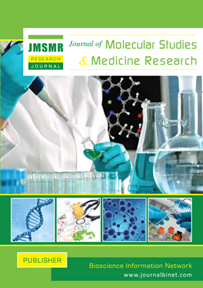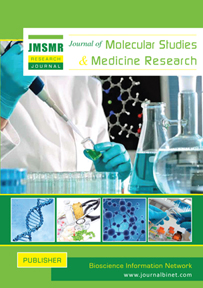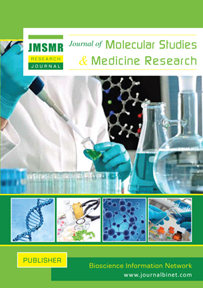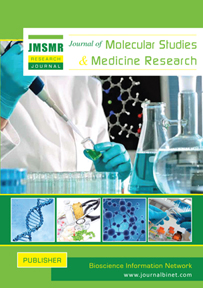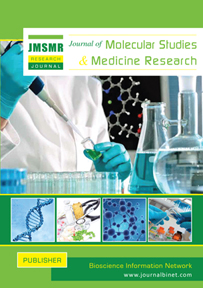Journal of Molecular Studies and Medicine Research
Volume 02 - Issue 01 | Year of Publication: 2017
Article Type: Research Article | No. 09 | Country: Bangladesh | pp. 70-79 | Open Access
Title: Factors affecting contraceptive use among married women of reproductive age in Bangladesh
Authors: Kibria, G. M. A., Hossen, S., Barsha, R. A. A., Sharmeen, A., Paul, S. K. & Uddin, S. M. I. (2016)
DOI: http://dx.doi.org/10.18801/jmsmr.020116.09
Title: Factors affecting contraceptive use among married women of reproductive age in Bangladesh
Authors: Kibria, G. M. A., Hossen, S., Barsha, R. A. A., Sharmeen, A., Paul, S. K. & Uddin, S. M. I. (2016)
DOI: http://dx.doi.org/10.18801/jmsmr.020116.09
Title: Factors affecting contraceptive use among married women of reproductive age in Bangladesh
Abstract:
Background: Contraceptive prevalence rate is low in Bangladesh. It needs to increase contraceptive prevalence rate in order to achieve the health related targets of Sustainable Development Goals (SDGs) by reducing pregnancy and pregnancy related outcomes. Aim of this study is to observe the factors which affect contraceptive use among Bangladeshi women. The hypothesis is that contextual factors along with individual and fertility related factors contribute to the use of contraceptives.
Materials and Methods: Bangladesh Demographic and Health Survey (BDHS) of 2014 is the seventh DHS undertaken from June to December, 2014. 18,245 ever-married women were identified and 17,863 were interviewed. Finally, 12,042 women were eligible for analysis after excluding pregnant women, women who were not married, with hysterectomy, postpartum amenorrheic, infertile or subfecund and sexually inactive. Main outcome measure was current use of contraception by married non-pregnant women.
Results: Contraceptive prevalence rate was 81.27%. Logistic regression was applied to calculate odds ratios (OR), 95% confidence interval (CI) and P value. Contraceptive use was affected by contextual factors along with individual and fertility related factors. Visits by a family planning worker (FPW) within the previous six months had the biggest impact on contraceptive use (the adjusted OR, 2.06; 95% CI, 1.61-2.64; p<0.001). Education level (adjusted OR, 1.67; 95% CI, 1.10-2.37; p<0.05 in the group with higher education) and number of children who are alive were also positively associated with contraceptive use (p<0.001). Contraceptive use was lower among Muslims (adjusted OR, non-Muslims vs. Muslims, 1.68; 95% CI, 1.27-2.22; p<0.001), desire for a son (adjusted OR, 0.69; 95% CI, 0.59-0.79; p<0.001), living in rural area (adjusted OR of rural vs. urban, 0.7; 95% CI, 0.59-0.84; p<0.001) and Sylhet Division (adjusted OR of Sylhet vs. Barisal, 0.54; 95% CI, 0.40-0.71; p<0.001).
Conclusion: Providing service through FPW, increasing the education level of women, intervention in rural areas and in Sylhet division, targeting Muslim population and women with higher age could increase the use of contraceptives among Bangladeshi women.
Key Words: Contraceptive, Married-women and Bangladesh
Abstract:
Background: Contraceptive prevalence rate is low in Bangladesh. It needs to increase contraceptive prevalence rate in order to achieve the health related targets of Sustainable Development Goals (SDGs) by reducing pregnancy and pregnancy related outcomes. Aim of this study is to observe the factors which affect contraceptive use among Bangladeshi women. The hypothesis is that contextual factors along with individual and fertility related factors contribute to the use of contraceptives.
Materials and Methods: Bangladesh Demographic and Health Survey (BDHS) of 2014 is the seventh DHS undertaken from June to December, 2014. 18,245 ever-married women were identified and 17,863 were interviewed. Finally, 12,042 women were eligible for analysis after excluding pregnant women, women who were not married, with hysterectomy, postpartum amenorrheic, infertile or subfecund and sexually inactive. Main outcome measure was current use of contraception by married non-pregnant women.
Results: Contraceptive prevalence rate was 81.27%. Logistic regression was applied to calculate odds ratios (OR), 95% confidence interval (CI) and P value. Contraceptive use was affected by contextual factors along with individual and fertility related factors. Visits by a family planning worker (FPW) within the previous six months had the biggest impact on contraceptive use (the adjusted OR, 2.06; 95% CI, 1.61-2.64; p<0.001). Education level (adjusted OR, 1.67; 95% CI, 1.10-2.37; p<0.05 in the group with higher education) and number of children who are alive were also positively associated with contraceptive use (p<0.001). Contraceptive use was lower among Muslims (adjusted OR, non-Muslims vs. Muslims, 1.68; 95% CI, 1.27-2.22; p<0.001), desire for a son (adjusted OR, 0.69; 95% CI, 0.59-0.79; p<0.001), living in rural area (adjusted OR of rural vs. urban, 0.7; 95% CI, 0.59-0.84; p<0.001) and Sylhet Division (adjusted OR of Sylhet vs. Barisal, 0.54; 95% CI, 0.40-0.71; p<0.001).
Conclusion: Providing service through FPW, increasing the education level of women, intervention in rural areas and in Sylhet division, targeting Muslim population and women with higher age could increase the use of contraceptives among Bangladeshi women.
Key Words: Contraceptive, Married-women and Bangladesh
APA (American Psychological Association)
Kibria, G. M. A., Hossen, S., Barsha, R. A. A., Sharmeen, A., Paul, S. K. & Uddin, S. M. I. (2016). Factors affecting contraceptive use among married women of reproductive age in Bangladesh. Journal of Molecular Studies and Medicine Research, 02(01), 70-79.
MLA (Modern Language Association)
Kibria, G. M. A., Hossen, S., Barsha, R. A. A., Sharmeen, A., Paul, S. K. & Uddin, S. M. I. ''Factors affecting contraceptive use among married women of reproductive age in Bangladesh''. Journal of Molecular Studies and Medicine Research, 02.01.(2016), 70-79.
Chicago/Turabian
Kibria, G. M. A., Hossen, S., Barsha, R. A. A., Sharmeen, A., Paul, S. K. & Uddin, S. M. I. ''Factors affecting contraceptive use among married women of reproductive age in Bangladesh''. Journal of Molecular Studies and Medicine Research, 02, no. 01.(2016), 70-79.
.
Kibria, G. M. A., Hossen, S., Barsha, R. A. A., Sharmeen, A., Paul, S. K. & Uddin, S. M. I. (2016). Factors affecting contraceptive use among married women of reproductive age in Bangladesh. Journal of Molecular Studies and Medicine Research, 02(01), 70-79.
MLA (Modern Language Association)
Kibria, G. M. A., Hossen, S., Barsha, R. A. A., Sharmeen, A., Paul, S. K. & Uddin, S. M. I. ''Factors affecting contraceptive use among married women of reproductive age in Bangladesh''. Journal of Molecular Studies and Medicine Research, 02.01.(2016), 70-79.
Chicago/Turabian
Kibria, G. M. A., Hossen, S., Barsha, R. A. A., Sharmeen, A., Paul, S. K. & Uddin, S. M. I. ''Factors affecting contraceptive use among married women of reproductive age in Bangladesh''. Journal of Molecular Studies and Medicine Research, 02, no. 01.(2016), 70-79.
.
Article Type: Research Article | No. 10 | Country: Bangladesh | pp. 80-87 | Open Access
Title: Antimicrobial sensitivity patterns among the sepsis patients in the intensive care unit of Dhaka Medical College Hospital, Bangladesh
Authors: Khan, A. M., Jannat, F. T. and Ahasan, M. F.
DOI: https://doi.org/10.18801/jmsmr.020117.10
Title: Antimicrobial sensitivity patterns among the sepsis patients in the intensive care unit of Dhaka Medical College Hospital, Bangladesh
Authors: Khan, A. M., Jannat, F. T. and Ahasan, M. F.
DOI: https://doi.org/10.18801/jmsmr.020117.10
Title: Antimicrobial sensitivity patterns among the sepsis patients in the intensive care unit of Dhaka Medical College Hospital, Bangladesh
Background: Sepsis is a leading cause of mortality in Intensive Care Unit (ICU) patients. Rapid initiation of effective empirical therapy lessens both patient mortality rates and time spent in ICU. Objective of the study was to identify microorganisms isolated from sepsis patients in ICU and determine the antimicrobial sensitivity patterns.
Methodology: Hospital based cross-sectional study was conducted among 80 culture positive sepsis patients in the ICU of Dhaka Medical College Hospital (DMCH).
Results: Most commonly source of isolated organisms were from respiratory (30.0%), genitourinary (23.8%), blood (18.8%) and gastrointestinal (16.3%) sources. Overall gram negative organisms (70.0%) were more common than gram negative organisms (22.5%). The most common organisms in respiratory, genitourinary, gastrointestinal, blood, CSF and pus were Acinatobacter sp. & Streptococcus pneumoniae (25.0%), E. coli (31.6%), E.coli (46.2%), Pseudumonas sp. (60.0%), Neisseria meningitis (60.0%), Staphylococcus aureus (100.0%), respectively. The highest susceptibility was for Colistin (100.0%), Imipenem (73.0%), Moxifloxacin (31.4%) and Piperacillin (68.0%). Gram negative bacteria were found most sensitive to Colistin (100.0%), Imipenem (82.1%), Moxifloxacin (71.43%), Piperacillin (68.14%) and Amikacin (65.85%) whereas gram positive bacteria to 100% sensitive to Cloxicillin, Azithromicin, Vancomycin and Piperacillin.
Conclusion: Judicious practice of antimicrobial agents for empirical therapy is essential for effective management of sepsis patients in ICU.
Key Words: Antimicrobial sensitivity pattern, Sepsis and ICU
Background: Sepsis is a leading cause of mortality in Intensive Care Unit (ICU) patients. Rapid initiation of effective empirical therapy lessens both patient mortality rates and time spent in ICU. Objective of the study was to identify microorganisms isolated from sepsis patients in ICU and determine the antimicrobial sensitivity patterns.
Methodology: Hospital based cross-sectional study was conducted among 80 culture positive sepsis patients in the ICU of Dhaka Medical College Hospital (DMCH).
Results: Most commonly source of isolated organisms were from respiratory (30.0%), genitourinary (23.8%), blood (18.8%) and gastrointestinal (16.3%) sources. Overall gram negative organisms (70.0%) were more common than gram negative organisms (22.5%). The most common organisms in respiratory, genitourinary, gastrointestinal, blood, CSF and pus were Acinatobacter sp. & Streptococcus pneumoniae (25.0%), E. coli (31.6%), E.coli (46.2%), Pseudumonas sp. (60.0%), Neisseria meningitis (60.0%), Staphylococcus aureus (100.0%), respectively. The highest susceptibility was for Colistin (100.0%), Imipenem (73.0%), Moxifloxacin (31.4%) and Piperacillin (68.0%). Gram negative bacteria were found most sensitive to Colistin (100.0%), Imipenem (82.1%), Moxifloxacin (71.43%), Piperacillin (68.14%) and Amikacin (65.85%) whereas gram positive bacteria to 100% sensitive to Cloxicillin, Azithromicin, Vancomycin and Piperacillin.
Conclusion: Judicious practice of antimicrobial agents for empirical therapy is essential for effective management of sepsis patients in ICU.
Key Words: Antimicrobial sensitivity pattern, Sepsis and ICU
APA (American Psychological Association)
Khan, A. M., Jannat, F. T. and Ahasan, M. F. (2017). Antimicrobial sensitivity patterns among the sepsis patients in the intensive care unit of Dhaka Medical College Hospital, Bangladesh. Journal of Molecular Studies and Medicine Research, 02(01), 80-87.
MLA (Modern Language Association)
Khan, A. M., Jannat, F. T. and Ahasan, M. F. ''Antimicrobial sensitivity patterns among the sepsis patients in the intensive care unit of Dhaka Medical College Hospital, Bangladesh''. Journal of Molecular Studies and Medicine Research, 02.01.(2017), 80-87.
Chicago/Turabian
Khan, A. M., Jannat, F. T. and Ahasan, M. F. ''Antimicrobial sensitivity patterns among the sepsis patients in the intensive care unit of Dhaka Medical College Hospital, Bangladesh''. Journal of Molecular Studies and Medicine Research, 02, no. 01.(2017), 80-87.
Khan, A. M., Jannat, F. T. and Ahasan, M. F. (2017). Antimicrobial sensitivity patterns among the sepsis patients in the intensive care unit of Dhaka Medical College Hospital, Bangladesh. Journal of Molecular Studies and Medicine Research, 02(01), 80-87.
MLA (Modern Language Association)
Khan, A. M., Jannat, F. T. and Ahasan, M. F. ''Antimicrobial sensitivity patterns among the sepsis patients in the intensive care unit of Dhaka Medical College Hospital, Bangladesh''. Journal of Molecular Studies and Medicine Research, 02.01.(2017), 80-87.
Chicago/Turabian
Khan, A. M., Jannat, F. T. and Ahasan, M. F. ''Antimicrobial sensitivity patterns among the sepsis patients in the intensive care unit of Dhaka Medical College Hospital, Bangladesh''. Journal of Molecular Studies and Medicine Research, 02, no. 01.(2017), 80-87.
Article Type: Research Article | No. 11 | Country: Bangladesh | pp. 88-98 | Open Access | Remark: This article has been RETRACTED.
Title: Association of safe delivery practice with socio-economic status and antenatal counseling in rural Bangladesh
Authors: Kibria, G. M. A., Islam, A., Paul, S. K. and Shah, R.
DOI: https://doi.org/10.18801/jmsmr.020117.11
Title: Association of safe delivery practice with socio-economic status and antenatal counseling in rural Bangladesh
Authors: Kibria, G. M. A., Islam, A., Paul, S. K. and Shah, R.
DOI: https://doi.org/10.18801/jmsmr.020117.11
Title: Association of safe delivery practice with socio-economic status and antenatal counseling in rural Bangladesh
Abstract
Context: Globally, around one-third million women die of pregnancy related causes in low and middle income countries. Unhygienic pregnancy and delivery practices, delivery conducted by unskilled birth attendants in unsafe delivery places are cumulative results from inadequate antenatal counseling and postpartum care to women in need. Designing a community based Maternal, Newborn, and Child Health Promotion (MNCHP) Program demands to identify socio-demographic determinants of safe delivery practices among rural women. This study made an attempt to investigate the socio-demographic determinants of safe delivery practice and to unfold any association between safe delivery practices and antenatal care (ANC) counseling to pregnant women at the community level in rural Bangladesh.
Materials and Methods: The study followed a cross-sectional design. The study was conducted in Alinogor and Charkhai unions of Beanibazar Upazilla’ in Sylhet district, Bangladesh during september-november 2009 among all recently delivered women who delivered their last child within last 30 months. A total of 542 recently delivered women were enrolled in the study. Two indicators were used to model safe delivery practice as the outcome. The first pertained to whether the delivery was conducted by a skilled health professional versus another person, regardless of delivery site. The second indicator was based on delivery site - at home versus at a health facility. Logistic regression was performed to estimate odds ratio (OR), 95% confidence interval (CI) and significance level (p-value).
Results: Women with higher educational status, younger age and lower parity were more likely to use trained attendant at birth and to deliver at health facilities. For each year increase in attending school, women had an estimated 15% higher odds of delivering at health facilities than women who never attended school for education (adjusted OR: 1.15, p <0.001). Women who never delivered a child before this index delivery (primipara) were 20% more likely to go for delivering at facility compared to women who had delivered earlier (adjusted OR : 0.80, p = 0.003). Women who made ANC visit once were 33% more likely to deliver at facilities (Adjusted OR : 1.33, p < 0.001) compared to women who never had an ANC visit during index pregnancies.
Conclusion: This study demonstrated antenatal counseling as a significant potential predictor to promote safe delivery practices among rural pregnant women, this study results can help intervening women’s access and utilization of antenatal counseling services at the community level which would be critical to improve safe delivery practices within rural population.
Keywords: Antenatal counseling, Delivery practice, Socio-economic status, Determinants and Rural Bangladesh
Abstract
Context: Globally, around one-third million women die of pregnancy related causes in low and middle income countries. Unhygienic pregnancy and delivery practices, delivery conducted by unskilled birth attendants in unsafe delivery places are cumulative results from inadequate antenatal counseling and postpartum care to women in need. Designing a community based Maternal, Newborn, and Child Health Promotion (MNCHP) Program demands to identify socio-demographic determinants of safe delivery practices among rural women. This study made an attempt to investigate the socio-demographic determinants of safe delivery practice and to unfold any association between safe delivery practices and antenatal care (ANC) counseling to pregnant women at the community level in rural Bangladesh.
Materials and Methods: The study followed a cross-sectional design. The study was conducted in Alinogor and Charkhai unions of Beanibazar Upazilla’ in Sylhet district, Bangladesh during september-november 2009 among all recently delivered women who delivered their last child within last 30 months. A total of 542 recently delivered women were enrolled in the study. Two indicators were used to model safe delivery practice as the outcome. The first pertained to whether the delivery was conducted by a skilled health professional versus another person, regardless of delivery site. The second indicator was based on delivery site - at home versus at a health facility. Logistic regression was performed to estimate odds ratio (OR), 95% confidence interval (CI) and significance level (p-value).
Results: Women with higher educational status, younger age and lower parity were more likely to use trained attendant at birth and to deliver at health facilities. For each year increase in attending school, women had an estimated 15% higher odds of delivering at health facilities than women who never attended school for education (adjusted OR: 1.15, p <0.001). Women who never delivered a child before this index delivery (primipara) were 20% more likely to go for delivering at facility compared to women who had delivered earlier (adjusted OR : 0.80, p = 0.003). Women who made ANC visit once were 33% more likely to deliver at facilities (Adjusted OR : 1.33, p < 0.001) compared to women who never had an ANC visit during index pregnancies.
Conclusion: This study demonstrated antenatal counseling as a significant potential predictor to promote safe delivery practices among rural pregnant women, this study results can help intervening women’s access and utilization of antenatal counseling services at the community level which would be critical to improve safe delivery practices within rural population.
Keywords: Antenatal counseling, Delivery practice, Socio-economic status, Determinants and Rural Bangladesh
APA (American Psychological Association)
Kibria, G. M. A., Islam, A., Paul, S. K. and Shah, R. (2017). Association of safe delivery practice with socio-economic status and antenatal counseling in rural Bangladesh. Journal of Molecular Studies and Medicine Research, 02(01), 88-98.
MLA (Modern Language Association)
Kibria, G. M. A., Islam, A., Paul, S. K. and Shah, R. ''Association of safe delivery practice with socio-economic status and antenatal counseling in rural Bangladesh''. Journal of Molecular Studies and Medicine Research, 02.01.(2017), 88-98.
Chicago/Turabian
Kibria, G. M. A., Islam, A., Paul, S. K. and Shah, R. ''Association of safe delivery practice with socio-economic status and antenatal counseling in rural Bangladesh''. Journal of Molecular Studies and Medicine Research, 02, no. 01.(2017), 88-98.
Kibria, G. M. A., Islam, A., Paul, S. K. and Shah, R. (2017). Association of safe delivery practice with socio-economic status and antenatal counseling in rural Bangladesh. Journal of Molecular Studies and Medicine Research, 02(01), 88-98.
MLA (Modern Language Association)
Kibria, G. M. A., Islam, A., Paul, S. K. and Shah, R. ''Association of safe delivery practice with socio-economic status and antenatal counseling in rural Bangladesh''. Journal of Molecular Studies and Medicine Research, 02.01.(2017), 88-98.
Chicago/Turabian
Kibria, G. M. A., Islam, A., Paul, S. K. and Shah, R. ''Association of safe delivery practice with socio-economic status and antenatal counseling in rural Bangladesh''. Journal of Molecular Studies and Medicine Research, 02, no. 01.(2017), 88-98.
Volume 02 - Issue 02 | Year of Publication: 2017 and 2018
Article Type: Research Article | No. 12 | Country: Bangladesh | pp. 99-107 | Open Access
Title: Factors associated to knowledge on nosocomial infection among the staff nurses in four hospitals of Dhaka, Bangladesh
Authors: Rahman, M. S., Khan, A. M., Nahar, N. and Ahasan, M. F.
DOI: https://doi.org/10.18801/jmsmr.020217.12
Title: Factors associated to knowledge on nosocomial infection among the staff nurses in four hospitals of Dhaka, Bangladesh
Authors: Rahman, M. S., Khan, A. M., Nahar, N. and Ahasan, M. F.
DOI: https://doi.org/10.18801/jmsmr.020217.12
Title: Factors associated to knowledge on nosocomial infection among the staff nurses in four hospitals of Dhaka, Bangladesh
Abstract
Background: Nurses can play an important role in controlling nosocomial infection. The objective of this study was to assess the factors associated with level of knowledge of the staff nurses on nosocomial infection.
Methods: The study was a cross sectional study carried out among 125 staff nurses working in four selected hospitals in Dhaka city. Structured questionnaire including a set of 30 questions for assessing the knowledge level used in this study.
Results: Majority of the respondents were females (74.0%) with a mean age of 24.7 ± 3.3 years. A greater proportion was educated in Diploma in Nursing (88.0%) and had less than one year of working experience (42.4%). Out of total score of 30, 33.6% scored ≤20, which was considered as poor knowledge, 40.8% scored 21–25 which was considered as average knowledge, and only 25.6% scored 26-30 which was considered as good knowledge. Educational qualification (p=0.020) and duration of service experience (p=0.043) were associated with the level of knowledge. Participation of training on infection control program was not associated with the knowledge level on nosocomial infection.
Conclusion: Knowledge of majority of the staff nurses on nosocomial infection is at poor to average level in Bangladesh. More emphasis should be given in academic curriculum, effective participation in infection control training program and hands-on training during service to reach their knowledge to a better level to ensure quality of nursing care.
Key Words: Nosocomial infection, Hospital acquired infection, Staff nurse and Knowledge
Abstract
Background: Nurses can play an important role in controlling nosocomial infection. The objective of this study was to assess the factors associated with level of knowledge of the staff nurses on nosocomial infection.
Methods: The study was a cross sectional study carried out among 125 staff nurses working in four selected hospitals in Dhaka city. Structured questionnaire including a set of 30 questions for assessing the knowledge level used in this study.
Results: Majority of the respondents were females (74.0%) with a mean age of 24.7 ± 3.3 years. A greater proportion was educated in Diploma in Nursing (88.0%) and had less than one year of working experience (42.4%). Out of total score of 30, 33.6% scored ≤20, which was considered as poor knowledge, 40.8% scored 21–25 which was considered as average knowledge, and only 25.6% scored 26-30 which was considered as good knowledge. Educational qualification (p=0.020) and duration of service experience (p=0.043) were associated with the level of knowledge. Participation of training on infection control program was not associated with the knowledge level on nosocomial infection.
Conclusion: Knowledge of majority of the staff nurses on nosocomial infection is at poor to average level in Bangladesh. More emphasis should be given in academic curriculum, effective participation in infection control training program and hands-on training during service to reach their knowledge to a better level to ensure quality of nursing care.
Key Words: Nosocomial infection, Hospital acquired infection, Staff nurse and Knowledge
APA (American Psychological Association)
Rahman, M. S., Khan, A. M., Nahar, N. and Ahasan, M. F. (2017). Factors associated to knowledge on nosocomial infection among the staff nurses in four hospitals of Dhaka, Bangladesh. Journal of Molecular Studies and Medicine Research, 02(02), 99-107.
MLA (Modern Language Association)
Rahman, M. S., Khan, A. M., Nahar, N. and Ahasan, M. F. ''Factors associated to knowledge on nosocomial infection among the staff nurses in four hospitals of Dhaka, Bangladesh''. Journal of Molecular Studies and Medicine Research, 02.02.(2017), 99-107.
Chicago/Turabian
Rahman, M. S., Khan, A. M., Nahar, N. and Ahasan, M. F. ''Factors associated to knowledge on nosocomial infection among the staff nurses in four hospitals of Dhaka, Bangladesh''. Journal of Molecular Studies and Medicine Research, 02, no. 02.(2017), 99-107
Rahman, M. S., Khan, A. M., Nahar, N. and Ahasan, M. F. (2017). Factors associated to knowledge on nosocomial infection among the staff nurses in four hospitals of Dhaka, Bangladesh. Journal of Molecular Studies and Medicine Research, 02(02), 99-107.
MLA (Modern Language Association)
Rahman, M. S., Khan, A. M., Nahar, N. and Ahasan, M. F. ''Factors associated to knowledge on nosocomial infection among the staff nurses in four hospitals of Dhaka, Bangladesh''. Journal of Molecular Studies and Medicine Research, 02.02.(2017), 99-107.
Chicago/Turabian
Rahman, M. S., Khan, A. M., Nahar, N. and Ahasan, M. F. ''Factors associated to knowledge on nosocomial infection among the staff nurses in four hospitals of Dhaka, Bangladesh''. Journal of Molecular Studies and Medicine Research, 02, no. 02.(2017), 99-107
Article Type: Research Article | No. 13 | Country: Bangladesh | pp. 108-119 | Open Access
Title: Association of smoking and smokeless tobacco with migraine
Authors: Paul, S. K., Rahman, M. A., Hasan, K. M. and Rahman, M.
DOI: https://doi.org/10.18801/jmsmr.020218.13
Title: Association of smoking and smokeless tobacco with migraine
Authors: Paul, S. K., Rahman, M. A., Hasan, K. M. and Rahman, M.
DOI: https://doi.org/10.18801/jmsmr.020218.13
Title: Association of smoking and smokeless tobacco with migraine
Abstract
Background: Migraine is one of the most common headaches affecting the personal, social, and work life of those afflicted and tobacco is the single most preventable cause of death in the world today. The purpose of this study was to examine the relationship of both smoking and smokeless tobacco with migraine using a hospital-based case–control study design in Dhaka, Bangladesh.
Methods: A hospital based case-control study was conducted at the neurology outpatient department in Dhaka, Bangladesh. We enrolled 70 migraine cases during January-December 2014 in neurology outpatient department and 70 age group and sex matched controls from internal medicine and general surgery outpatient department of the study hospitals. Use of smokeless tobacco and smoking (cigarette/bidi/hukka) was determined by an interviewer administered questionnaire.
Results: There was no relation between alcohol consumption, BMI, sleep hours per day with migraine. There was an association between smoking, smokeless tobacco use with migraine. The crude OR of smoking was 2.17 (95% CI= 1.02 – 4.58) and after controlling of other variable the effect of smoking on migraine did not persist. The crude OR of 6-10 cigarettes and >10 cigarettes per day was respectively 4.25 (95% CI=1.45- 12.43) and 2.19 (95% CI 0.60- 7.95). The crude OR of smokeless tobacco was 2.63 (95% CI= 1.16 – 5.93) and after adjusting of other variable the effect of smokeless tobacco on migraine did not persist. The crude OR 1.7 (95% CI=0.63- 4.54) for ≤4 times and crude OR 4.51 (95% CI=1.19- 17.08) for ≥ 5 times smokeless tobacco use per day.
Conclusion: This study showed that both smoking and smokeless tobacco were associated with migraine but after adjusting of other variables the influence of smoking and smokeless tobacco on migraine did not persist. This study further showed that there was a dose response relationship between smoking and smokeless tobacco with migraine.
Key Words: Bangladesh, Headache, Non-communicable, Betel, Quid and Cancer
Abstract
Background: Migraine is one of the most common headaches affecting the personal, social, and work life of those afflicted and tobacco is the single most preventable cause of death in the world today. The purpose of this study was to examine the relationship of both smoking and smokeless tobacco with migraine using a hospital-based case–control study design in Dhaka, Bangladesh.
Methods: A hospital based case-control study was conducted at the neurology outpatient department in Dhaka, Bangladesh. We enrolled 70 migraine cases during January-December 2014 in neurology outpatient department and 70 age group and sex matched controls from internal medicine and general surgery outpatient department of the study hospitals. Use of smokeless tobacco and smoking (cigarette/bidi/hukka) was determined by an interviewer administered questionnaire.
Results: There was no relation between alcohol consumption, BMI, sleep hours per day with migraine. There was an association between smoking, smokeless tobacco use with migraine. The crude OR of smoking was 2.17 (95% CI= 1.02 – 4.58) and after controlling of other variable the effect of smoking on migraine did not persist. The crude OR of 6-10 cigarettes and >10 cigarettes per day was respectively 4.25 (95% CI=1.45- 12.43) and 2.19 (95% CI 0.60- 7.95). The crude OR of smokeless tobacco was 2.63 (95% CI= 1.16 – 5.93) and after adjusting of other variable the effect of smokeless tobacco on migraine did not persist. The crude OR 1.7 (95% CI=0.63- 4.54) for ≤4 times and crude OR 4.51 (95% CI=1.19- 17.08) for ≥ 5 times smokeless tobacco use per day.
Conclusion: This study showed that both smoking and smokeless tobacco were associated with migraine but after adjusting of other variables the influence of smoking and smokeless tobacco on migraine did not persist. This study further showed that there was a dose response relationship between smoking and smokeless tobacco with migraine.
Key Words: Bangladesh, Headache, Non-communicable, Betel, Quid and Cancer
APA (American Psychological Association)
Paul, S. K., Rahman, M. A., Hasan, K. M. and Rahman, M. (2018). Association of smoking and smokeless tobacco with migraine. Journal of Molecular Studies and Medicine Research, 02(02), 108-119.
MLA (Modern Language Association)
Paul, S. K., Rahman, M. A., Hasan, K. M. and Rahman, M.''Association of smoking and smokeless tobacco with migraine''. Journal of Molecular Studies and Medicine Research, 02.02 (2018), 108-119.
Chicago/Turabian
Paul, S. K., Rahman, M. A., Hasan, K. M. and Rahman, M. ''Association of smoking and smokeless tobacco with migraine''. Journal of Molecular Studies and Medicine Research, 02, no. 02 (2018), 108-119.
Paul, S. K., Rahman, M. A., Hasan, K. M. and Rahman, M. (2018). Association of smoking and smokeless tobacco with migraine. Journal of Molecular Studies and Medicine Research, 02(02), 108-119.
MLA (Modern Language Association)
Paul, S. K., Rahman, M. A., Hasan, K. M. and Rahman, M.''Association of smoking and smokeless tobacco with migraine''. Journal of Molecular Studies and Medicine Research, 02.02 (2018), 108-119.
Chicago/Turabian
Paul, S. K., Rahman, M. A., Hasan, K. M. and Rahman, M. ''Association of smoking and smokeless tobacco with migraine''. Journal of Molecular Studies and Medicine Research, 02, no. 02 (2018), 108-119.

